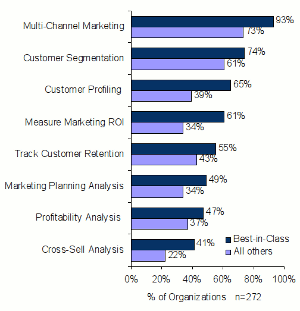
The role of the chief marketing officer (CMO) has evolved dramatically over the last 10 years. The average CMO is on the job for just 23.6 months. The CEO and board of directors are demanding a new level of accountability from senior marketing leaders, which requires tangible justification for marketing decisions. Marketers can no longer afford to make decisions or measure results based on gut feel. For CMOs, this leads to one undeniable truism: Job security is directly correlated with data-driven marketing.
It’s a bold statement, but one could postulate that marketing is one of the last holdouts in an organization when it comes to heavy reliance on data and tangible measurement to optimize performance. Finance, accounting, operations, and sales, for example, all rely on “the numbers.” The days when marketers could get away with trusting their gut feelings are coming to an end. In this consumer-driven environment, where expectations culminate in a one-to-one relationship with customers, the numbers have never been more important.
Few marketers would argue that data is not essential to making marketing more efficient and effective. Likewise, few CEOs, shareholders, and board members would argue marketing effectiveness isn’t a top concern, particularly for an ongoing expense that will always have some degree of qualitative benefit.
In September 2009, Aberdeen surveyed 272 organizations from all industries and company sizes to benchmark the current use of data-driven decisions in marketing. How do organizations use data, and what are some of the biggest challenges facing the market today?
Identifying return on marketing investment was a top challenge for 49 percent of all respondents who indicated that”linking sales to marketing for ROI analysis” was the biggest challenge with respect to data-driven marketing. An inability to properly allocate sales to marketing investments (49 percent of all respondents) leaves many marketers wondering which combination of marketing channels delivers the biggest bang for the buck.
The data also suggests that for many marketers, the challenge with data-driven marketing is not a lack of data but a lack of actionable insight that can be derived from the data that already exists. When asked about the top three challenges with marketing data, 47 percent of respondents indicated one of the top three was an inability to translate data into business insight. Unfortunately, data quality issues (40 percent) and disparate data silos (36 percent) across the organization add to the challenge of fostering a “data-driven approach” in marketing.
Data-Driven Marketing in Best-in-Class Organizations
Best-in-class organizations are predominantly using data to segment and target the market (74 percent) to develop more impactful delivery of multi-channel campaigns (93 percent). However, the research reveals that best-in-class is 1.7 times more likely than all other organizations to use customer data to develop customer profiles. These customer profiles help standardize customer segments and targets for the organization and simplify cross-channel engagement campaigns.
Best Buy is a great example of a Best-in-Class organization that uses customer profiles to train in-store employees. About a year ago, Best Buy’s “customer personas” training document was leaked to the press. The document outlined unique customer personas that would help in-store employees (otherwise known as “blue shirts”) engage with customers and enhance customer service based on customer profiles or “personas.”
Current Best-in-Class Use of Marketing Data
While measuring marketing return is a top strategy for all organizations, Best-in-Class firms also reveal they are 1.8 times more likely than All Others to actively attempt to use customer data for measuring marketing returns. Best-in-Class are also more likely to use customer data to engage in modeling techniques for profitability analysis (47 percent of Best-in-Class currently using), lifetime value analysis (27 percent), predictive modeling (25 percent), behavioral modeling (22 percent) and marketing mix modeling (20 percent).
The data-driven marketing revolution is upon us. Today’s multi-channel environment demands a structured approach to customer engagement and marketing measurement. Data becomes the lifeblood for all organizations and the key to CMO job security. All organizations are looking to link marketing analytics to real business strategy. This is accomplished through context, which is derived from data and experience.
Best-in-class organizations revealed data is heavily used for customer engagement through segmentation, customer profiling, and multi-channel initiatives. Best-in-class firms were also 2.7 times more likely than all others to rely heavily on data for marketing decisions. More importantly, superior-performing organizations have injected process and structure into data-driven marketing.
By engaging multiple functions in marketing analysis and developing process-driven data quality capabilities, Best-in-Class firms have secured a lasting competitive advantage that makes it impossible for Industry Average and Laggard performing organizations to ignore data-driven marketing.
Ian Michiels is a research director and the practice leader of the Customer Management Technology Group at the Aberdeen Group.





















































Ian, think you are right in that high-quality data is essential for CMO success. Was reading how Gartner estimates the cost of poor data quality at a staggering $8.2 million for an average business. The article (on PBBI blog) also provided insights on how organizations can best make a business case for DQ. Worth a read if you get a chance ebs.pbbiblogs.com/2009/09/08/the-business-case-for-data-quality/